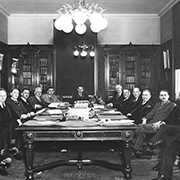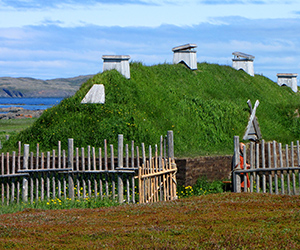CANADA HISTORY
Liberals win Quebec

The political landscape of Quebec underwent a seismic shift during the mid-20th century, a change deeply rooted in the political and social upheavals that followed the Great Depression of the 1930s. This era shaped provincial politics across Canada, but its effects were especially pronounced in Quebec, where the combination of economic devastation, rising nationalism, and a complex relationship between government, business, and the Catholic Church formed the foundation of modern Quebec politics. Central to this transformation was the rise and fall of the Union Nationale and the emergence of the Quiet Revolution under Jean Lesage and the Quebec Liberal Party.
The Rise of the Union Nationale
The Great Depression hit Quebec hard, leaving many workers unemployed and impoverished. This economic crisis, combined with widespread dissatisfaction with traditional political elites, gave rise to new political forces. The most significant of these was the Union Nationale, a party formed in 1935 by a coalition of conservatives and nationalists. Led by the charismatic and authoritarian Maurice Duplessis, the Union Nationale capitalized on Quebec's conservative social structure, forging strong alliances with powerful institutions like the Catholic Church and big business. Duplessis's political vision was built on defending the traditional values of Quebec’s rural, Catholic, and French-speaking population, with a clear opposition to socialism, labor movements, and any form of perceived federal interference.
Duplessis’s government, first elected in 1936, was marked by a deep-rooted conservatism that resonated with many Quebecers at the time. His alliance with the Catholic Church allowed the Church to maintain significant control over education, healthcare, and social services, while big business, especially in the resource-rich industries, thrived under minimal state interference. This political structure ensured that the Union Nationale dominated provincial politics for nearly a quarter-century, with only brief interruptions. The Union Nationale's rule resembled a quasi-feudal system, in which the Church, business elites, and rural landowners had disproportionate influence over the political process, leaving little room for progressive reform or opposition.
The Death of Duplessis and the End of an Era
The dominance of the Union Nationale began to unravel with the death of Maurice Duplessis in 1959, an event that shook the foundations of Quebec's political landscape. Duplessis had been the undisputed leader of the province, using his iron-fisted approach to suppress dissent, including the labor movement, which had gained momentum after World War II. Under Duplessis, Quebec was often referred to as a "Grande Noirceur" or "Great Darkness," a period characterized by conservative governance, patronage, and resistance to change. The government’s opposition to union activity, as well as its deep ties to the Church and big business, led to a growing frustration among Quebec’s burgeoning urban middle class and its working class, which sought greater control over their economic and social destinies.
After Duplessis's death, his party scrambled to find a successor who could maintain the Union Nationale’s grip on power. Paul Sauvé succeeded him as Premier, but his tenure was tragically brief—lasting only 112 days before he too passed away from a heart attack. Sauvé’s brief time in office is remembered for his attempt to rejuvenate the Union Nationale through his "100 Days of Change" program, signaling a potential shift toward modernization. However, with Sauvé's death, momentum for reform stalled, and the Union Nationale returned to its conservative roots under Antonio Barrette, an uninspiring leader who could not halt the party’s decline. The stage was set for a seismic shift in Quebec politics.
The Rise of Jean Lesage and the Quiet Revolution
Jean Lesage, a seasoned federal politician who had served as a Liberal MP in the Canadian Parliament, entered provincial politics in 1958 with a bold vision for Quebec. A progressive who believed in the power of government to drive change, Lesage sought to lead Quebec into a new era of modernization, away from the traditionalism and conservatism that had defined Duplessis's reign. In the 1960 election, the Quebec Liberal Party campaigned under the slogan "C’est le temps que ça change" ("It’s time for a change"), capturing the growing desire for reform in Quebec society.
The election marked the beginning of the Quiet Revolution—a period of rapid modernization and secularization in Quebec. The Liberals won 51 seats to the Union Nationale’s 43, ending the long dominance of the Union Nationale and ushering in a new era of Quebec politics. The Lesage government sought to reshape Quebec’s economy and society, reducing the influence of the Church, strengthening the role of the state, and asserting Quebec’s autonomy within Canada. A defining feature of this period was the nationalization of electricity through the creation of Hydro-Québec, which gave Quebec control over its natural resources and became a symbol of the province’s newfound confidence in its ability to manage its own affairs.
Under Lesage, Quebec underwent significant social and economic changes. Education and healthcare, long controlled by the Catholic Church, were secularized and brought under state control. The government also expanded social programs, invested in infrastructure, and sought to modernize the province’s economy by promoting industrial development. These reforms helped to transform Quebec from a largely agrarian society into a modern, urban, and industrialized province.
"Maîtres Chez Nous": Masters in Our Own Home
In 1962, Lesage’s government sought a fresh mandate to continue its ambitious reform agenda. The Liberals campaigned under the slogan "Maîtres chez nous" ("Masters in Our Own Home"), a powerful expression of Quebec’s desire for greater autonomy and control over its economic and political destiny. This slogan resonated deeply with Quebecers, particularly as the Quiet Revolution fostered a new sense of pride and nationalism. The Liberals won a decisive victory in the 1962 election, securing 63 seats and solidifying their hold on power.
This victory marked a turning point in Quebec’s history, as the province began to assert itself more forcefully within the Canadian federation. The Quiet Revolution, while primarily focused on domestic reforms, also laid the groundwork for the emergence of the Quebec sovereignty movement. Many Quebecers, inspired by the success of the Lesage government in reclaiming control over the province’s economy and institutions, began to question whether Quebec’s aspirations could be fully realized within the framework of Canadian federalism.
The Decline of the Union Nationale and the Rise of the Parti Québécois
The Union Nationale briefly returned to power in 1966 under Daniel Johnson Sr., but the party’s days as a dominant force in Quebec politics were numbered. The social and political changes ushered in by the Quiet Revolution had fundamentally altered the province’s political landscape, and the Union Nationale’s conservative platform no longer resonated with the majority of Quebecers. By the 1970s, the party had all but disappeared from provincial politics.
In its place, a new political force emerged: the Parti Québécois (PQ), led by former Liberal cabinet minister René Lévesque. The PQ built on the nationalist sentiments stirred by the Quiet Revolution, advocating for Quebec’s sovereignty and independence from Canada. While the Quiet Revolution had been focused on reforming Quebec within the Canadian federation, the PQ argued that only full independence could allow Quebec to truly "be master in its own house." This marked the beginning of a new chapter in Quebec’s political history, as the province’s future relationship with the rest of Canada became a central issue in its political discourse.
Conclusion
The Great Depression, the rise and fall of the Union Nationale, and the Quiet Revolution were critical moments in Quebec’s political evolution. The death of Maurice Duplessis and the collapse of his party marked the end of an era of conservative dominance, while the rise of Jean Lesage and the Liberals heralded a new era of reform and modernization. The Quiet Revolution not only transformed Quebec’s economy and society but also fostered a new sense of nationalism that would ultimately lead to the rise of the Parti Québécois and the sovereignty movement.
The reforms of the Quiet Revolution fundamentally changed Quebec’s relationship with the rest of Canada, laying the groundwork for future debates about the province’s place within the federation. The period also marked Quebec’s emergence as a modern, secular, and urban society, moving away from its traditional rural and religious roots. The political transformations of this era continue to shape Quebec’s identity and its role within Canada to this day, making the Great Depression, the rise of the Union Nationale, and the Quiet Revolution pivotal moments in Canadian history.
Cite Article : www.canadahistory.com/sections/documents




